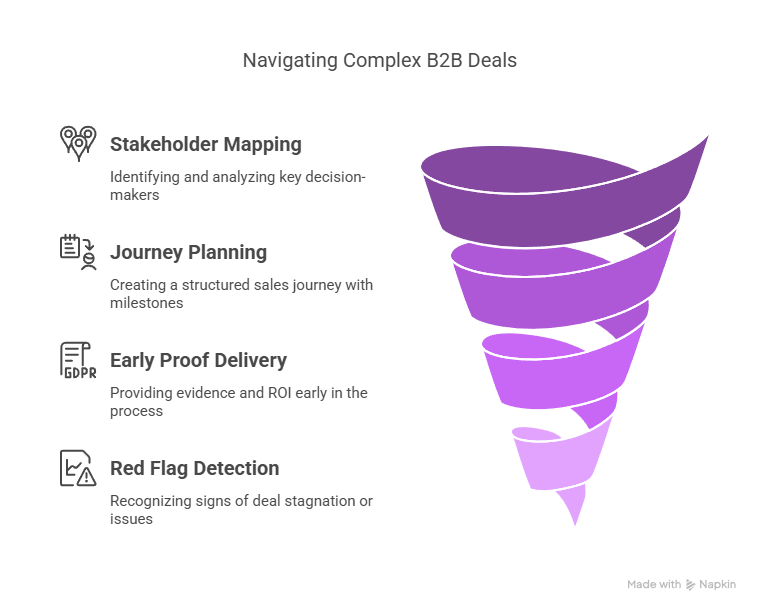It's Not the Budget. It's You. (And How to Fix It Before It's Too Late)
3 min read


The Deal That Died at the Finish Line
The deal was done. Or so we thought.
The CEO said yes. The CFO gave the green light.
We were days away from signing.
Then came the cold, short email:
"After consultation with the procurement team, we've decided to pause the project for now."
Procurement? Nobody even mentioned them.
That moment taught us a painful truth: In complex B2B deals, what you don’t map will kill your deal. And it’s a trap that most SMBs fall into: Mistaking early enthusiasm from one or two contacts as validation, without understanding the real decision-making structure behind the scenes.
Myth-Busting: Why B2B Deals Really Fall Apart
"Deals don’t fall apart because of budget. They fall apart because you didn’t uncover who holds the brakes."
Budget is often just a polite excuse. Real reasons include internal misalignment, unvoiced objections, departmental friction, and the failure to clearly demonstrate value and ROI to all stakeholders.
In complex B2B sales – especially in competitive markets like Israel – success demands a shift from reactive selling to proactive deal leadership.
The 3 Silent Deal-Killers
1. Betting Everything on the "Champion"
Building a strong relationship with an internal champion is important – but it’s not enough. Real B2B decisions involve a Decision-Making Unit (DMU), including finance, procurement, legal, IT, end users, influencers, and senior management.
Failing to map this web leads to disaster. Adobe, for instance, developed a stakeholder mapping system that tracks both formal and informal influencers. Microsoft prioritized consensus over champion strength. Accenture positioned itself as a strategic advisor by helping clients map their own buying process.
2. No Clear Next Steps After the First Meeting
A great first meeting means nothing without a concrete follow-up. Ambiguity is your enemy.
Companies like Cisco and VMware combat this with Mutual Action Plans (MAPs) – joint roadmaps agreed upon early, detailing every step, every player, and every milestone. This structure keeps momentum and reduces risk.
3. No Early "Proof Assets"
Don’t wait until the proposal stage to bring out your case studies and ROI calculators. That’s too late.
Clients need proof early to build confidence and help champions win internal battles.
Ex Libris increased conversion rates by preemptively sharing relevant industry research. Deloitte invested in thought leadership to position itself as a trusted advisor. A SaaS firm cut its sales cycle in half by using short customer testimonial videos in early nurturing stages.
Red Flags: How to Spot a Deal Going Cold
"We’ll get back to you soon." = Avoidance.
"Looks interesting, but we need to think about it." = Unclear value.
"Just send a proposal." = You’re being sidelined.
Israeli-specific cues:
"We’re too busy right now." = Indefinite deferral.
"We need to check with X." = Hidden stakeholders.
"Budget is frozen." = Maybe, but verify.
Silence after a good meeting = Lost momentum.
Ignoring these signs is surrendering control.
Take Back Control: A Practical Playbook
A. Map Real Stakeholders
Use questions like:
"Who else needs to be involved?"
"How have similar decisions been made before?"
Then analyze each stakeholder:
Role and influence
Interests and fears
Support level (ally/neutral/blocker)
Internal dynamics
Use a stakeholder map. Adobe analyzes relationship dynamics. Accenture uses decision architecture modeling. You should too.
B. Plan the Customer Journey Proactively
Don’t just book the next call. Plan the entire sales journey
Stages (Demo, ROI, Legal, Procurement, Final Approval)
Participants per stage
Timelines and expected outcomes
Documented Mutual Action Plan
VMware creates tailored implementation roadmaps before deal closure to preempt risks.
C. Deliver Proof Early
Match proof assets to journey stage:
Early: Thought leadership, webinars, industry reports
Mid: ROI calculators, tailored case studies, value demos
Late: Business cases, legal templates, security docs
Use social proof. Quantify everything. Enable buying, not just selling.
Believer Meats used webinars to attract strategic partners early. A SaaS firm boosted lead quality with short, targeted video testimonials.


Final Thought
If you don’t control the internal map, you’re not running a deal. You’re running on hope.
A good meeting, verbal enthusiasm, or even a "yes" from a senior exec means little without a clear view of the internal decision structure.
Hope is not a closing strategy.
Control comes from stakeholder mapping, journey planning, and early value proof.
Bottom Line:
In complex B2B sales, you’re not selling. You’re navigating. The tools are in your hands. Use them wisely.
Address
4/12 Gershon Sharshevski,
Mazkeret Batya, Israel


